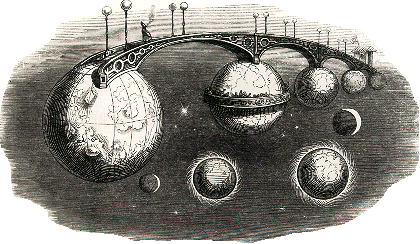- United States: The Library of Congress
- Canada: National Library of Canada
- Italy: Discoteca di Stato
- Germany: Deustche Bibliothek
- United Kingdom: The British Library

Logo of Bibliotheca Universalis 'Planètes: les mystères de l'infini'
by Grandville, in 'Un autre monde', 1844
(by courtesy of Bibliothèque nationale de France).
Objectives
The main objective of Bibliotheca Universalis is to make the major works
of the world's scientific and cultural heritage accessible to a vast public
via multimedia technologies, thus fostering the exchange of knowledge and
dialogue over national and international borders. The aim is to exploit
existing digitization programs in order to build up a large distributed
virtual collection of knowledge and make it available via the global communication
networks, enhancing the services to the end users. In this way, it is hoped
to advance international cooperation towards the establishment of a global
electronic library system.
Bibliotheca Universalis should strengthen the function of libraries and
improve international availability of digitized resources, including not
only bibliographic records but also the information content (integrating
text, graphics, still images, sound and video information). It will promote
large scale digitizing techniques and encourage the definition and adoption
of global standards. Furthermore, it should demonstrate how integrated digitization
techniques can support long term preservation as well as enabling immediate
access to the information digitized. The project initially involves national
libraries and other major libraries and could be extended to other countries
than G7. All documents would belong to the public domain.
Context
In most countries, considerable efforts have been taken, often for centuries,
to preserve, describe and index the national cultural wealth. More recently,
libraries have begun to digitize at least part of this information. Digitization
means creating multimedia databases enhanced by digital information, and
thus offering easy access to cultural and scientific heritage for a large
population of users. This digitization effort will have to be continued
for a number of years to reach some degree of coverage. The intention is
to build up rapidly very large information services containing millions
of documents.
Bibliotheca Universalis should provide a practical framework for international
cooperation; whilst building on existing initiatives, it will address inter-operability
problems, thus creating an open environment which can facilitate participation
beyond G7 countries. It should also stimulate the effective management of
these cultural and knowledge resources and the development of functions
for user friendly retrieval of relevant information. It will address the
needs of the general public, researchers, scholars and students.
Architecture
A network architecture with dedicated hosts and a common interface for retrieval
and navigation tools will be implemented. Existing standards in the fields
of text, image and sound digitization and of communication protocols will
be employed.
Technological priorities concern the network environment, the management
of distributed systems based on client/server model, and advanced retrieval
functionalities. The navigation tools must allow the end user to:
